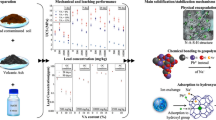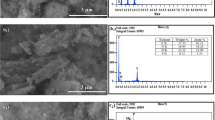Environmentally safe pigments based on synthetic zeolite and monophosphates of zinc, calcium, and manganese were obtained by mechanochemical synthesis. Optimal conditions for their dispersion were determined. Scanning electron microscopy and energy dispersive analysis were used to evaluate the surface morphology and determine the elemental composition of the obtained pigment, which indicate the intercalation of phosphorus and relevant metals into the zeolite structure. Desorption of phosphate anions in a 0.1% NaCl solution was found to increase in the series \(\text{Na-A/Zn}{({\text{H}}_{2}{{\text{PO}}}_{4})}_{2}-{\text{Na-A/Ca(H}}_{2}{{\text{PO}}}_{4}{\text{)}}_{2}-{\text{Na-A/Mn(H}}_{2}{{\text{PO}}}_{4}{\text{)}}_{2}\), and the maxima of their concentrations for all the compositions were detected after 48 h of holding. The concentration of desorbed phosphate anions in the studied environment during mechanochemical synthesis is approx. 2.0 times higher than that during ion-exchange synthesis. The obtained results indicate the effectiveness of the mechanochemically obtained pigment based on zinc monophosphate and zeolite as part of paint coatings for the protection of structures made of aluminum alloys.


Similar content being viewed by others
References
C. Leygraf, I. Wallinder, J. Tidblad, and T. Graedel, Atmospheric Corrosion, John Wiley & Sons, Inc., New Jersey (2016).
V. I. Pokhmurs’kyi, M. S. Khoma, V. I. Kopylets’, and S. A. Kornii, “Investigation of the initial stage of selective dissolution of zinc-aluminum alloys in chloride-containing media,” Mater. Sci., 39, No. 3, 394–399 (2003); DOI: https://doi.org/10.1023/B:MASC.0000010745.55466.f7.
S. Zhang, T. Zhang, Y. He, Y. Feng, X. Du, B. Ma, and T. Zhang, “Effect of coastal atmospheric corrosion on fatigue properties of 2024-T4 aluminum alloy structures,” J. of Alloys and Comp., 802, 511–521 (2019); DOI: https://doi.org/10.1016/j.jallcom.2019.06.235.
S. A. Korniy, I. M. Zin, O. P. Khlopyk, M. B. Tymus, and M. Y. Holovchuk, “Influence of a phosphate–nitrate composition on the corrosion of mechanically activated aluminum alloy,” Mater. Sci., 57, No. 2, 284–290 (2021); DOI: https://doi.org/10.1007/s11003-021-00543-0.
I. M. Zin, S. A. Kornii, A. R. Kytsya, L. M. Bilyi, M. O. Danylyak, and P. Y. Lyutyi, “Protective properties of alkyd coatings inhibited by complex zeolite-phosphate pigment,” Mater. Sci., 56, No. 2, 284–289 (2020); DOI: https://doi.org/10.1007/s11003-020-00427-9.
S. B. Lyon, R. Bingham, and D. J. Mills, “Advances in corrosion protection by organic coatings: what we know and what we would like to know,” Prog. Org. Coat., 102, 2–7 (2017); DOI: https://doi.org/10.1016/j.porgcoat.2016.04.030.
M. Kendig, S. Jeanjaquet, R. Addison, and J. Waldrop, “Role of hexavalent chromium in the inhibition of corrosion of aluminum alloys,” Surf. and Coat. Techn., 140, Is. 1, 58–66 (2001); DOI: https://doi.org/10.1016/S0257-8972(01)01099-4.
J. Sinko, “Challenges of chromate inhibitor pigments replacement in organic coatings,” Progress in Organic Coatings, 42, 267–282 (2001); DOI: https://doi.org/10.1016/S0300-9440(01)00202-8.
O. Gharbi, S. Thomas, C. Smith, and N. Birbilis, “Chromate replacement: what does the future hold?”, NPJ Mater. Degradation, 2, Is. 1, 1–8 (2018); DOI: https://doi.org/10.1038/s41529-018-0034-5.
Y. Hao, F. Liu, E. Han, S. Anjum, and G. Xu, “The mechanism of inhibition by zinc phosphate in an epoxy coating,” Corr. Sci., 69, 77–86 (2013); DOI: https://doi.org/10.1016/j.corsci.2012.11.025.
Y. Shao, C. Jia, G. Meng, T. Zhang, and F. Wang, “The role of a zinc phosphate pigment in the corrosion of scratched epoxy-coated steel,” Corr. Sci., 51, 371–379 (2009); DOI: https://doi.org/10.1016/j.corsci.2008.11.015.
M. A. Mahdavian, and M. M. Attar, “Investigation on zinc phosphate effectiveness at different pigment volume concentrations via electrochemical impedance spectroscopy,” Electrochim. Acta, 50, Is. 24, 4645–4648 (2005); DOI: https://doi.org/10.1016/j.electacta.2005.02.015.
H. Völz, J. Kischkewitz, P. Woditsch, A. Westerhaus, W. Griebler, M. Liedekerke, and H. Gaedcke, Pigments, Inorganic. Ullmann’s Encyclopedia of Industrial Chemistry, Wiley-VCH, Weinheim (2006); DOI: https://doi.org/10.1002/14356007.a20_243.pub2.
H. Wan, D. Song, X. Li, D. Zhang, J. Gao, and C. Du, “Effect of zinc phosphate on the corrosion behavior of waterborne acrylic coating/metal interface,” Materials, 10, Is. 6, 654 (2017); DOI: https://doi.org/10.3390/ma10060654.
O. Dagdag, A. Harfi, L. Gana, Z. Hlimi, H. Erramli, O. Hamed, and S. Jodeh, “The role of zinc phosphate pigment in the anticorrosion properties of bisphenol a diglycidyl ether-polyaminoamide coating for aluminum alloy AA2024-T3,” J. of Bio-and Tribo-Corr., 5, Is. 1, 1–10 (2019); DOI: https://doi.org/10.1007/s40735-018-0200-x.
V. Pokhmurs’kyi, L. Kwiatkowski, I. Zin, S. Lyon, L. Bilyi, and M. Ratushna, “Corrosion protection of aluminum alloys by inhibiting pigments alloy,” Mater. Sci., 42, No. 5, 573–578 (2006); DOI: https://doi.org/10.1007/s11003-006-0118-1.
C. Deya, R. Romagnoli, and B. Del Amo, “A new pigment for smart anticorrosive coatings,” J. of Coat. Techn. and Res., 4, Is. 2, 167–175 (2007); DOI: https://doi.org/10.1007/s11998-007-9021-4.
S. I. Snizhko, Evaluation and Forecasting of the Quality of Natural Waters [in Ukrainian], Nika Center, Kyiv (2001).
DSTU 8056:2015. Reagents and Especially Pure Substances. Methods of Preparation of Indicator Solutions [in Ukrainian], Introduced on 22.06.2015.
Acknowledgements
This research was supported by the National Research Foundation of Ukraine under the project number 2020.02/0063, “Synthesis and properties of new complex anticorrosion pigments for paint coatings based on aluminosilicate nanocontainers”.
Author information
Authors and Affiliations
Corresponding author
Additional information
Translated from Fizyko-Khimichna Mekhanika Materialiv, Vol. 58, No. 4, pp. 81–85, July–August, 2022.
Rights and permissions
Springer Nature or its licensor (e.g. a society or other partner) holds exclusive rights to this article under a publishing agreement with the author(s) or other rightsholder(s); author self-archiving of the accepted manuscript version of this article is solely governed by the terms of such publishing agreement and applicable law.
About this article
Cite this article
Halaichak, S.A., Datsko, B.M., Holovchuk, M.Y. et al. Comparison of the Sorption Capacities of Synthetic Zeolite and Divalent Metal Phosphates. Mater Sci 58, 513–518 (2023). https://doi.org/10.1007/s11003-023-00692-4
Received:
Published:
Issue Date:
DOI: https://doi.org/10.1007/s11003-023-00692-4




